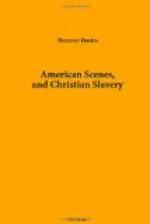There is a “Society of Inquiry” in connection with the seminary, which has a distinct library of 326 volumes. “The Reading Room and Athenaeum” is furnished with 21 newspapers, and several of the best literary and theological periodicals.
From the library, my guide (one of the students) led me down into the lecture-room, where Professor Stowe was engaged with a Hebrew class. They were reading in the Song of Solomon. The exhibition did not strike me as much superior to what we used to have at Rotherham College ten or twelve years ago. In point of domestic comfort, the latter is incomparably before Lane Seminary, and in literary advantages not far behind. Professor Stowe kindly drove me back to Cincinnati in his buggy, or waggon, or phaeton.
Lane Seminary is an institution devoted entirely to theological education, in connection with the New-School Presbyterians. The building, including chapel and library, cost about 50,000 dollars, or 10,000_l._, and must have been very cheap at that. In 1828-30, Ebenezer Lane, Esq., and his brother Andrew Lane, Esq., made a donation of 4,000 dollars for the purpose of establishing the seminary, whereupon it was incorporated under the name of “Lane Seminary,” and trustees were appointed. To these trustees the Rev. Mr. Kemper and his sons made over, for the benefit of the institution, 60 acres of land, including the site on which the buildings stand. In 1832 Arthur Tappan, Esq., of New York, subscribed 20,000 dollars for the Professorship of Theology. In the same year 15,000 dollars were raised for the Professorship of Ecclesiastical History; the largest contributor to which was Ambrose White, Esq., of Philadelphia: and an equal sum was contributed for the Professorship of Biblical Literature,—Stephen Van Rennselaer, Esq., of Albany, being the chief contributor. In 1835, a fund of 20,000 dollars was raised for the Professorship of Sacred Rhetoric, of which a large portion was given by John Tappan, Esq., of Boston. A literary department was organized in 1829, which was discontinued in 1834; at which period the institution, in its full operation as a Theological Seminary, may be said to have commenced. Since then it has sent forth about 250 ministers!
Candidates for admission must produce satisfactory testimonials, that they are members, in good standing, of some Christian Church; that they possess competent talents; and that they have regularly graduated at some college or university, or have pursued a course of study equivalent to the common college course.
The course of study occupies three years; and every student is expected to enter with the intention of completing the full course. So far as practicable, the different branches are pursued simultaneously. Thus the department of Biblical Literature, during the first year, occupies three days in the week; during the second, two; and during the third, one: Church History, one day in the week: Sacred Rhetoric




